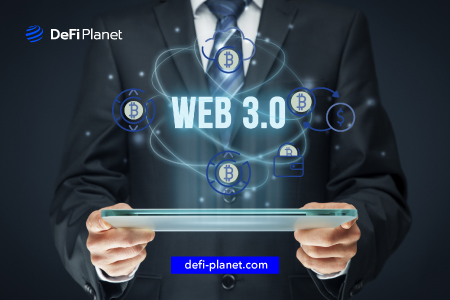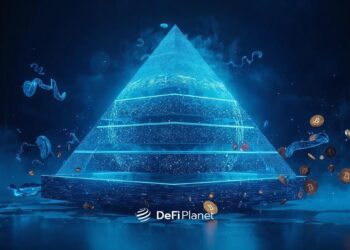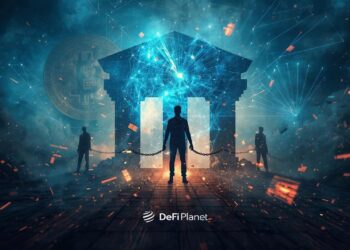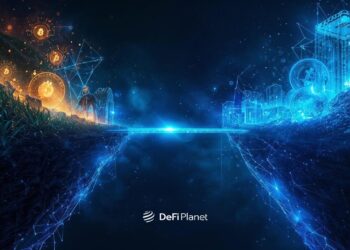Imagine a re-invention of the internet as we know it.
- A completely decentralized internet that gives users complete control over their data.
- Unrestricted access to ultra-personalized internet services.
- Online brands incorporating new tokenomics into their operations.
These are just a handful of the numerous benefits that Web 3 promises.
Web 3 has become a buzzword in the blockchain community. Various projects are consistently working to upgrade the current Web 2 that is in use to a better model, Web 3. This new architecture is expected to usher in decentralization while simultaneously addressing the concerns identified in Web 2.
This article concisely analyzes the various aspects of Web 3.
What is Web3?
Web 3 is a new internet model that promises improved functionality by integrating innovative features such as AI, blockchain technology, machine learning, and much more into apps and websites.
Before it was renamed Web 3, Tim Berners-Lee, the inventor of the World Wide Web, christened this upgraded version of the internet, Semantic Web. Gavin Wood, a co-founder of Ethereum, coined the name Web 3.
Decentralization is a key feature of Web3, allowing data to flow freely while granting users full control. It is in stark contrast to Web2, which was characterized by centralization and was dominated by a few tech giants such as Facebook and Google.
Though Web 3 is already a well-known name in the blockchain ecosystem, it will also interface with many other technologies. Decentralization is one of the reasons blockchain technology is so significant in this new generation of the internet. Because of its censor-resistant feature, people will be able to easily share information as they see fit, and smart contracts will automate transactions.
Before diving into the depths of Web 3, it is worthwhile to take a brief look at its predecessors, Web 1 and 2.
Brief Overview of Web 1 and Web 2
Web 1
The internet began with the development of Web1, and it was considerably different from what is now in use. The internet was not readily accessible at the time. Most people couldn’t utilize it or publish content on it. The creation of static pages, often containing people’s personal information, was the trend. Motion videos, which are now prevalent on the internet, did not exist during the Web1 era and there were just a few ads.
Web 2
The world is currently enjoying the benefits of Web 2. It introduced the concept of interpersonal interaction. Social media is a feature of Web 2 development that allows for improved interpersonal communication. With the advent of Web 2, brands could post responsive content on their websites and apps and engage with a global audience.
APIs (Application Programming Interfaces) are used to perform various tasks and build custom applications. It is easy to access information on many websites and submit feedback to website owners. Advertisements are ubiquitous on websites and search engine result pages.
A defining feature of Web 2 is its domination by globally renowned technology companies such as Google and Facebook. This centralized feature is one of the reasons for the growing demand for a better version (Web 3).
Web 3 in Blockchain and Cryptocurrency
Web 3 is ushering in an upgraded model of the internet, and it will rely on blockchain technology for numerous reasons. The current internet is centralized and controlled by companies such as Google and Facebook, which profit from user data.
It’s rare to come across an interactive app on Web 2 that compensates users for using their data for advertising and other purposes.
With the decentralization that blockchain technology will bring to Web3, control will no longer be in the hands of a few tech behemoths to use as they see fit. Web 3 is expected to provide a more seamless experience, with users only needing one account to access different websites and apps.
Brands can easily incentivize customers by incorporating tokens into their architecture. For example, if a customer shops on a Web 3 e-commerce site, they may have access to tokens in the loyalty program.
Shortcomings of the current Web 2
Web 2 is plagued by issues, which has increased demand for Web 3. Some of the disadvantages of Web 2 are listed below.
• Centralization
Web 2 is highly centralized, with the power of the internet firmly in the hands of Big Tech companies like Facebook and Google. If the above-mentioned tech giants refuse to acknowledge one’s existence, the individual or brand may cease to exist on the internet. With the internet’s immense power, particularly in terms of user data, it is imprudent for only a few organizations to dominate it.
A successful attack on Google could cripple the activities of brands and individuals worldwide because they use services offered by the popular tech company. Private details like passwords and email addresses are stored on Google, meaning that any compromise from the tech company could shut people out from their various accounts on different websites and apps.
• Illegal Use of Customer Data
The Cambridge Analytica scandal demonstrated the implications of exploiting Big Tech companies’ access to customer data. Cambridge Analytica collected personal data without consent and used it to develop political campaign strategies. The company was able to access data and create psychological profiles of people using the This Is Your Digital Life app while pinching data linked to their friends. Cambridge Analytica took advantage of a data harvesting operation on Facebook.
With the above example in mind, it is evident that internet centralization could have disastrous consequences.
• Censorship
Censorship is a byproduct of Web 2 architecture. Though people have the freedom to express their thoughts and share information, the internet is largely censored. People can be taken off of several social media platforms, such as Facebook, for mentioning certain words.
Web 2 vs Web 3
Web 3 is an upgraded version of Web 2, but it differs from the latter in several respects, some of which are explained below.
• Censorship
Centralized media platforms, such as Facebook, can censor and ban users, whereas Web3 platforms can not. The latter is well-known for its support for decentralization.
• Downtime
Web2 platforms are known to suffer downtime, which prevents their platforms from working. Web 3 utilizes blockchain technology, and blockchain networks such as Ethereum are not known for having downtime.
• KYC features
Many Web2 platforms, such as Facebook, request personal information from its users; however, Web3 social media platforms are expected not to do so.
Advantages of Web2
Web 2 offers several advantages to those who utilize its many features.
- Web 2 has a flexible interface design which makes it user-friendly.
- People can access the internet and websites from virtually any location.
- Web 2 websites and apps are easy to use because they have been available for a long time.
- Communication on Web 2 is generally smooth due to the different social media features available.
- Web 2 makes it simple to create content, and in some cases, users can upload their content for free.
Disadvantages of Web2
- Users must deal with censorship because their ideologies may prevent them from accessing certain platforms. One such example is Donald Trump.
- There is the risk of social media platforms exploiting users’ data and utilizing it for profit.
- Spamming is a major problem on Web 2 platforms. Users are not rewarded for being subjected to a barrage of commercials.
Advantages of Web3
- Users will benefit from better-optimized search results as a result of the application of AI and ML technology.
- In contrast to a centralized organization, users have complete authority over their data.
- As a result of AI, the internet becomes more personalized as the user experience is tailored to the user’s preferences.
Disadvantages of Web3
- Stringent privacy policies will be required.
- Because of Web3’s transparency, it is easy to access the details of users on the blockchain.
- It may be tough to adjust to because it is different from the status quo.
Challenges of Web 3.0 Implementation
Web3 is innovative, yet it poses several challenges.
• User experience
The elements that will constitute Web3 may require multiple processes that users are not currently accustomed to. Web3 platforms must overcome this limitation.
• Deciphering right data
AI is an important component of Web3, as it is used to filter data. Although artificial intelligence has enormous potential, humans may trick the system by providing it with inaccurate data. Deciphering the correct one may be difficult.
• Scalability issues
Web 3 platforms will be built on blockchain technology, which is dealing with scalability. Ethereum is one of the most reliable blockchains that has stood the test of time, yet it falls short of offering scalable transactions. The newest generation of blockchains has yet to provide solutions to the blockchain trilemma, with networks such as Solana occasionally breaking down.
• Financial issues
Depending on what one seeks to accomplish, developing an app or website on Web 2 may not be expensive. People can set up free websites and offer their services. This could be a concern in the early stages of Web3 adoption because the cost of developing a decentralized app is higher than the cost of developing a Web2-based app.
Web3 is innovative, yet it poses several challenges.
• User experience
The elements that will constitute Web3 may require multiple processes that users are not currently accustomed to. Web3 platforms must overcome this limitation.
• Deciphering right data
AI is an important component of Web3, as it is used to filter data. Although artificial intelligence has enormous potential, humans may trick the system by providing it with inaccurate data. Deciphering the correct one may be difficult.
• Scalability issues
Web 3 platforms will be built on blockchain technology, which is dealing with scalability. Ethereum is one of the most reliable blockchains that has stood the test of time, yet it falls short of offering scalable transactions. The newest generation of blockchains has yet to provide solutions to the blockchain trilemma, with networks such as Solana occasionally breaking down.
• Financial issues
Depending on what one seeks to accomplish, developing an app or website on Web 2 may not be expensive. People can set up free websites and offer their services. This could be a concern in the early stages of Web3 adoption because the cost of developing a decentralized app is higher than the cost of developing a Web2-based app.
Potential Drawbacks of Web 3
Web3 has some drawbacks that may affect its adoption.
- Because it relies on blockchain technology, Web3 will be very transparent, making it easier to access user data.
- Due to the esoteric nature of this universe, new users may struggle to adapt, resulting in a poor user experience.
- Current technological platforms may be unable to integrate Web3 seamlessly into their architecture. Existing devices may struggle to access services on the enhanced internet.
Future of Web 3
Both blockchain organizations and others outside the space are currently developing features that will drive the massive adoption of Web 3. In the future, we can expect the current Web 2 services, such as social media and e-commerce ecosystems, to be available on the upgraded version.
In Conclusion,
- Web 3 is a new model of the internet.
- It eliminates the element of centralization that is common in Web 2.
- Web 3 has some advantages and drawbacks.
- This newer model of the internet will be built using blockchain technology.
If you would like to read more articles like this, follow DeFi Planet on Twitter, LinkedIn and Facebook.





















